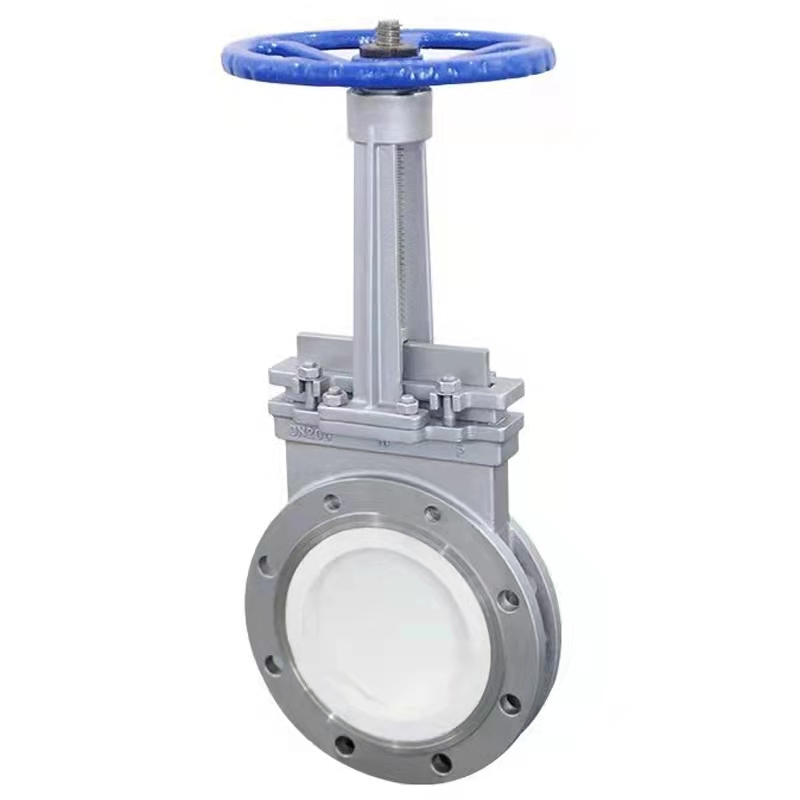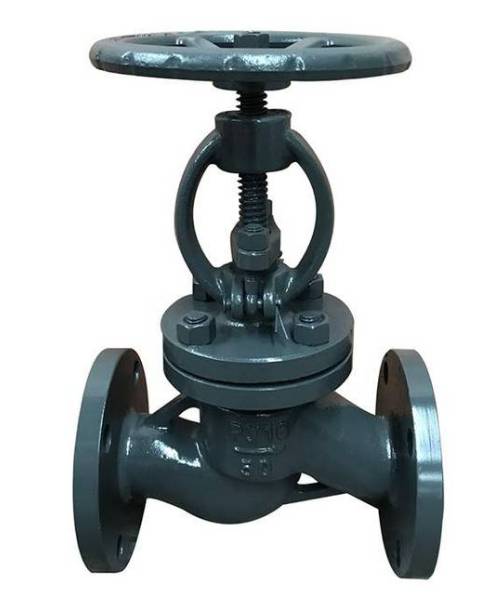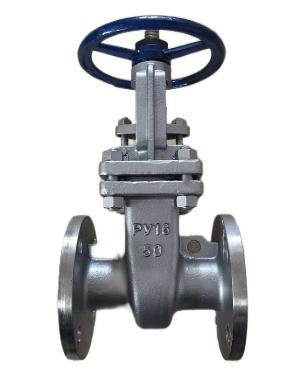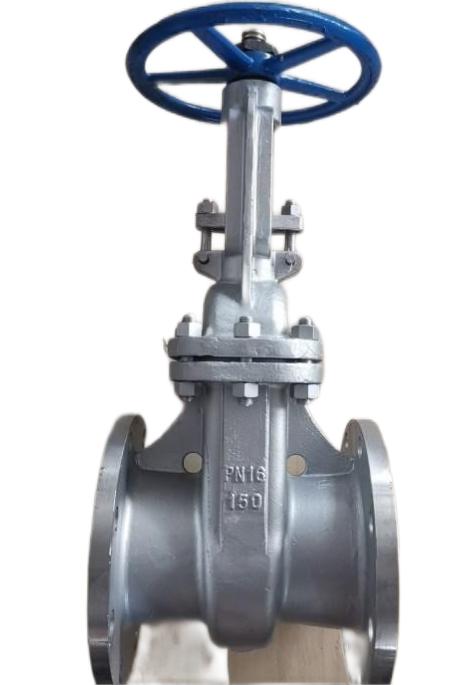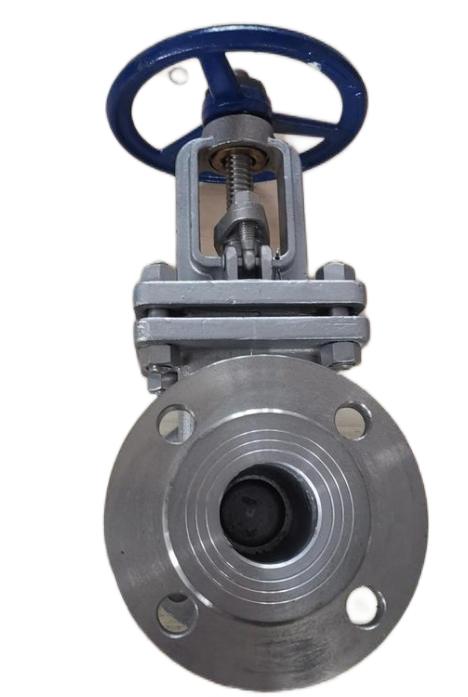Russian standard stainless steel flange gate valve - Working principle
The opening and closing component of the gate valve is the gate, and the movement direction of the gate is perpendicular to the direction of the fluid. The gate valve can only be fully opened and fully closed, and cannot be adjusted or throttled. The gate has two sealing surfaces, and the two sealing surfaces of the commonly used mode gate valve form a wedge shape. The wedge angle varies with the valve parameters, usually 5 °, and when the medium temperature is not high, it is 2 ° 52 '. The gate plate of a wedge gate valve can be made into a whole, called a rigid gate plate; It can also be made into a gate that can produce slight deformation to improve its processability and compensate for the deviation of the sealing surface angle during the processing. This type of gate is called an elastic gate. When the gate valve is closed, the sealing surface can only rely on medium pressure to seal, that is, relying on medium pressure to press the sealing surface of the gate plate towards the other side of the valve seat to ensure the sealing surface, which is self sealing. Most gate valves use forced sealing, which means that when the valve is closed, external force is used to forcefully press the gate plate towards the valve seat to ensure the sealing surface is sealed. The gate plate of a gate valve moves in a straight line with the valve stem, which is called a rising stem gate valve, also known as a rising stem gate valve. Usually, there is a trapezoidal thread on the lifting rod, which transforms the rotating motion into linear motion through the nut at the top of the valve and the guide groove on the valve body, that is, the operating torque is converted into the operating thrust. When opening the valve, when the lifting height of the gate is equal to 1:1 times the valve diameter, the fluid channel is completely unobstructed, but this position cannot be monitored during operation. In actual use, the vertex of the valve stem is used as the mark, that is, the position that cannot be opened, as its fully open position. To consider the phenomenon of lockup due to temperature changes, it is usually done by turning back 1/2 to 1 turn at the top position as the fully open valve position. Therefore, the fully open position of the valve is determined based on the position of the gate, i.e. the stroke. Some gate valves have a stem nut located on the gate, and the handwheel rotates to drive the stem to rotate, causing the gate to lift. This type of valve is called a rotary stem gate valve, or a non rising stem gate valve.
Stainless steel Russian standard gate valve - types
Rigid single gate valve
The connection size is also mostly inconsistent. Mainly divided into the following categories: 1. Mechanical standard valves produced according to JB/T2203-1999 "Gate Valve Structure Length"; 2. National standard valves produced according to GB/T12221-2005 "Structural Length of Metal Valves"; 3. American standard valves produced according to ASME B16.10-2009 "Face to Face and End to End Dimensions of Valves".
Gate valves are divided into two types based on the structure of the gate plate: wedge type and parallel type. There are three types of wedge gate structures: single gate, double gate, and elastic gate.
Gate valves are divided into flat gate valves and knife gate valves based on their different structural types.
Working principle of manual gate valve: Rotate the handwheel to lift or lower the valve plate connected to the valve stem through the threads of the handwheel and the valve stem, achieving the function of opening and closing.
According to the classification of shell/main material, gate valves can be divided into:
Metal material valves: such as carbon steel valves, alloy steel valves, stainless steel valves, cast iron valves, titanium alloy valves, Monel valves, copper alloy valves, lead alloy valves, etc.
Metal body lined valves: such as rubber lined valves, fluorine lined valves, lead lined valves, plastic lined valves, and enamel lined valves.
Non metallic material valves: such as ceramic valves, glass valves, and plastic valves.
Stainless steel Russian standard gate valve - advantages and disadvantages
1、 Advantages
1. Low flow resistance. The medium channel inside the valve body is straight, and the medium flows in a straight line with low flow resistance.
2. It saves effort when opening and closing. Compared to globe valves, the movement direction of the gate is perpendicular to the flow direction of the medium, whether it is open or closed.
3. High height, long opening and closing time. The opening and closing stroke of the ram is relatively large, and the lifting and lowering are carried out through screws.
4. Water hammer phenomenon is not easy to occur. The reason is that the shutdown time is long.
5. The medium can flow in any direction on both sides, making it easy to install. The two sides of the gate valve channel are symmetrical.
6. The structural length (the distance between the two connecting end faces of the shell) is relatively small.
7. Simple form, short structural length, good manufacturing process, and wide application range.
8. Compact structure, good valve rigidity, smooth channel, small flow resistance, sealing surface made of stainless steel and hard alloy, long service life, PTFE packing, reliable sealing, easy and flexible operation.
II. shortcoming
The sealing surfaces are prone to erosion and scratches, making maintenance difficult. The overall size is relatively large, requiring a certain amount of space for opening and closing, and the opening and closing time is long. The structure is relatively complex.
Parallel double gate valve
Russian Standard Gate Valve - Features:
Lightweight flat bottom gate seat
Traditional gate valves often accumulate foreign objects such as stones, wooden blocks, cement, iron filings, and debris in the grooves of the valve bottom after being washed with water, which can easily cause water leakage due to the inability to close tightly. The bottom of the elastic seat sealed gate valve adopts the same flat bottom design as the water pipe machine, which is not easy to cause debris to accumulate, making the fluid unobstructed.
Overall gluing
The ram adopts high-quality rubber for overall internal and external sealing. European rubber vulcanization technology ensures accurate geometric dimensions of the vulcanized ram, and the rubber and ductile cast ram are firmly connected, not easy to fall off, and have good elastic memory.
Russian standard stainless steel flange gate valve precision cast valve body
The valve body adopts precision casting, and the precise geometric dimensions ensure the sealing of the valve without any precision machining inside the valve body.
Stainless steel Russian standard gate valve - precautions
1. Handwheels, handles, and transmission mechanisms are not allowed for lifting purposes, and collisions are strictly prohibited.
2. Double gate valves should be installed vertically (i.e. the valve stem is in a vertical position and the handwheel is at the top).
3. Gate valves with bypass valves should be opened before opening (to balance the pressure difference between the inlet and outlet and reduce the opening force).
4. Install the gate valve with transmission mechanism according to the product manual.
5. If the valve is frequently opened and used, lubricate it once a month.
6. Gate valves are only used for fully opening and fully closing various pipelines or equipment for medium operation, and are not allowed for throttling purposes.
7. Gate valves with handwheels or handles should not have additional auxiliary bars added during operation (if the sealing is not tight, the sealing surface or other parts should be inspected and repaired). Rotate the handwheel and handle clockwise to close, otherwise to open. Gate valves with transmission mechanisms should be used in accordance with the product manual.
Hot Tags: Russian standard gate valve, China, Low Price, Buy Discount, Cheap, Discount, Factory, Manufacturers, Suppliers, Made in China, Brands, In Stock
 English
English  Español
Español  Português
Português  русский
русский  Français
Français  日本語
日本語  Deutsch
Deutsch  tiếng Việt
tiếng Việt  Italiano
Italiano  Nederlands
Nederlands  ภาษาไทย
ภาษาไทย  Polski
Polski  한국어
한국어  Svenska
Svenska  magyar
magyar  Malay
Malay  বাংলা ভাষার
বাংলা ভাষার  Dansk
Dansk  Suomi
Suomi  हिन्दी
हिन्दी  Pilipino
Pilipino  Türkçe
Türkçe  Gaeilge
Gaeilge  العربية
العربية  Indonesia
Indonesia  Norsk
Norsk  تمل
تمل  český
český  ελληνικά
ελληνικά  український
український  Javanese
Javanese  فارسی
فارسی  தமிழ்
தமிழ்  తెలుగు
తెలుగు  नेपाली
नेपाली  Burmese
Burmese  български
български  ລາວ
ລາວ  Latine
Latine  Қазақша
Қазақша  Euskal
Euskal  Azərbaycan
Azərbaycan  Slovenský jazyk
Slovenský jazyk  Македонски
Македонски  Lietuvos
Lietuvos  Eesti Keel
Eesti Keel  Română
Română  Slovenski
Slovenski  मराठी
मराठी  Srpski језик
Srpski језик 

